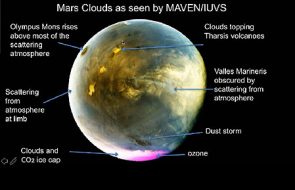NASA’s MAVEN orbiter has seen clouds grow and detected an ozone buildup on the Red Planet.
The Mars Atmosphere and Volatile Evolution Mission (MAVEN) arrived at Mars in 2014. Tasked with exploring the Red Planet’s climate history and atmosphere loss, MAVEN has watched how the solar wind strips the planet of its atmosphere (remember the Mohawk-esque particle plume?), detected a hemisphere-scale aurora, and found other curious goings-on.
The mission’s latest results, presented this week at the joint Division for Planetary Sciences and European Planetary Science Congress meeting in Pasadena, California, add to the unique view MAVEN is giving us of Mars.
Many of these results come from the spacecraft’s Imaging Ultraviolet Spectrometer (IUVS). IUVS is the marriage of a camera and a spectrometer: every pixel in one of its ultraviolet images contains a spectrum, capturing composition info and other details that a mere picture can’t.
Nick Schneider (University of Colorado, Boulder) and his fellow MAVEN members put together this false-color video of cloud formation on Mars as seen by the IUVS. Basically, it shows us what we’d see if we could see in UV. The video combines four images spanning nearly 7 hours, filling in the gaps between the images with simulated views. Credit: NASA / MAVEN / University of Colorado
Mars is bright in these images, the atmosphere scattering UV light and reflecting it back at MAVEN. (That’s why the planet’s left limb looks so bright.) Olympus Mons looks dark because it sticks above so much of the atmosphere, and the planet’s Grand-Canyon-on-steroids, Valles Marineris, is invisible beneath all the scattered light in the atmosphere above it.

The clouds visible in these IUVS images are made of water-ice crystals and are common on Mars. Notice as the video progresses and the local Martian day progresses to afternoon, clouds form and grow over the trio of Tharsis volcanoes Arsia Mons, Pavonis Mons, and Ascraeus Mons (on the diagonal, from bottom left to top right). These clouds are created as sunlight warms the surface, causing atmospheric gases just above the surface to rise higher, where they cool and condense — the same way such clouds form on Earth. And mountains are especially good at spurring cloud growth, because when air passes over them it’s pushed to higher altitudes, where it cools, causing the water vapor in it to condense. Over the course of 7 hours, the Tharsis clouds grew and combined into a front a thousand miles wide!
The pink cap at the planet’s bottom is a sort of ozone cap. MAVEN’s data reveal an ozone buildup over the planet’s south pole (currently in winter). The ozone seems to be funneled to here by circulation patterns in the atmosphere, which create a dry “hole” where water vapor is scarce. Since water vapor destroys ozone, the molecule accumulates in this polar vortez, Schneider explained in a press conference on October 17th.
You can read more about the MAVEN results in NASA’s press release.
Explore Mars for yourself with our set of Mars globes.
 0
0









Comments
You must be logged in to post a comment.